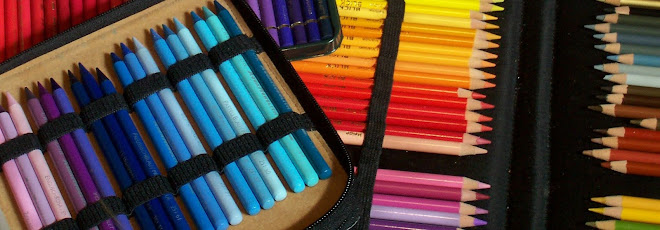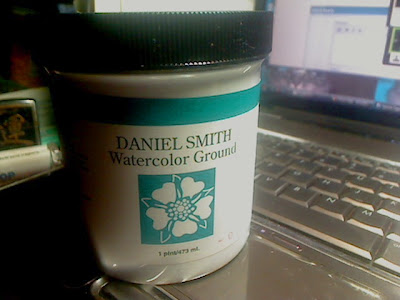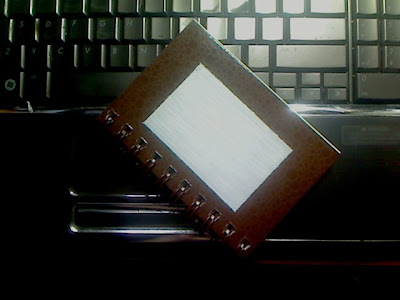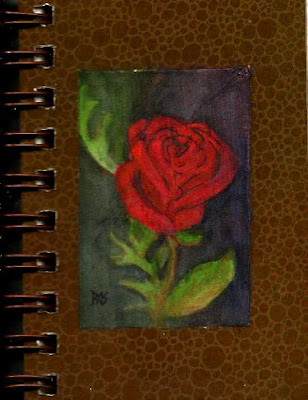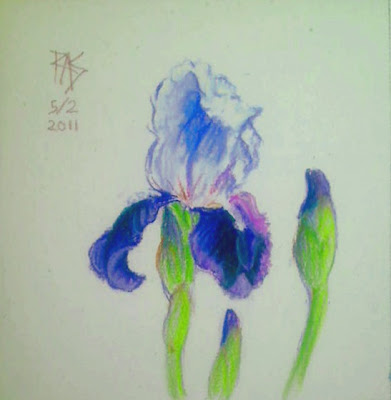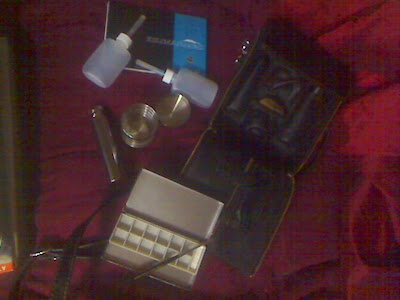
Joe Miller’s Signature Travel Kit is a luxury, not a necessity unless you don’t already have a plein air watercolor kit. If you do, it’s still a wonderful luxury item with a well designed real leather case, steel water bottles and collapsible water cups, a metal palette box, travel brush, elastic loops for more brushes and tools plus a postcard sized Kilimanjaro watercolor block. It contains everything you need except paint.

I didn’t realize until I had it in my hands that the metal palette box has a design on the lid. It’s ornamental and old fashioned, reminiscent of Victoriana or Old West saddle ornaments, any 19th century decorative elements. That gives me a little lift, makes me think of the days when adventurous people carried small watercolor sets across the globe instead of cameras. Like the leather and metal, it’s a small luxury element, something not necessary but very pleasant that gives me a feeling of prosperity and ease.

I waited for quite a while before purchasing it because I already use my Winsor & Newton Field Box whenever I go out to paint - or go out for anything, because I might get a a chance to stop and paint. But this small extravagance turned out to be more useful than I thought it would be.
For someone disabled who has mobility impairments as I do, taking your supplies to the living room or another room may be a plein air trip in itself. What’s convenient for hiking may also be convenient for someone working an office job who’d like to use lunches and breaks to improve their watercolor painting. The kit is well designed, classy and would not be out of place in a high end business environment, provided you’re willing to let your coworkers know you’re a painter.
The leather case is quite small, only 2” deep by 6” wide and 6 1/2” tall, external measurements. The shoulder strap is very long and can be shortened. Two side zipper pulls bring the front flap down. Elastic bands keep brushes and tools in place on the flap and on the back of the case, the only loose things in the bag are the postcard sized watercolor block and the palette box. The water bottles fit into pockets on the back with the two collapsible water cups between them in their pockets. This design keeps all the contents organized. Brushes don’t fall out and neither do any sketch pencils or other tools you want to tuck into the row of elastic bands on the flap.
The tall narrow water bottles hold quite a lot of water. So do the collapsible steel water cups. They hold firm when pulled up tightly, yet collapse again easily after emptying. Put in a pocket pack of facial tissues for cleanup and you can wipe them out on the spot in a lunch room, especially if you don’t fill them very deep. There’s room for that pack of tissues along with the original items, also for a pocket Moleskine or other small conveniences.
Because it’s so organized, I found myself using it often when I don’t feel like getting up to get water. The elastic band slots became a place I could always find my good travel brushes. The only improvement I’d suggest is replacing the small travel brush included with a larger round travel brush that has a cap. I keep the original Joe Miller one in an elastic band rather than inside the palette so that I don’t accidentally turn it hairs end down while it’s wet and destroy the brush. But a travel brush with a cap that fits inside the palette or a retractible brush like some travel brush models could sit in the palette in front of the half pans.
A waterbrush like the Niji Waterbrush or the Derwent Waterbrush would make this little kit even more convenient for someone who's convalescing or disabled. It might make a very good gift for crafty or artistic friends in the hospital, but I'd add a waterbrush to it along with a dozen tubes of good artist grade paint to make it a complete set.

The metal palette box is not enameled inside. It comes with 12 empty half pans to fill with your favorite tube watercolors. I chose 12 of my Daniel Smith watercolors to create a transparent palette, a little different from my other 12 color watercolor sets. Since then I’ve found myself using that little palette a lot more.
Refilling this palette can be a serious bargain and also give you more choice of colors than any 12 color pocket watercolor set. I chose Quinacridone Gold and Quinacridone Burnt Orange instead of Yellow Ochre and Burnt Sienna, both colors are much more transparent. Then added Sodalite Genuine, a mineral blue-black like Paynes Grey with a pretty texture instead of the usual Ivory Black. I could also load it with different seasonal palettes, switching out some colors for others to reflect changing sky and land hues.
It may help to tuck in a folding plastic palette for mixing on a white surface. I mixed in the metal lid of the little palette box and got good mixtures though. Otherwise you may want to add one of the inexpensive folding plastic palettes available at Blick or Daniel Smith, if you don’t like mixing on a shiny metal surface.
Either a waterbrush or a larger watercolor travel brush would be a good addition though. While the included pocket brush isn't as tiny as the ones in Winsor & Newton Field Boxes, it's still only a size 2 round. You may want to have a larger round such as a size 6, 8 or even 10. I added a size 8 round and a very large squirrel mop, both of them pocket brushes with caps, so that when I'm doing loose styles or large washes on the block I'm not struggling to do it with a detail brush. The case has extra loops for brushes so any short handled brush will fit in those loops or pockets. There's a perfect size pocket for that squirrel mop, which is so fat it's like a little metal cigar.
Because it’s so compact, well organized, convenient and decorative, Joe Miller’s Signature Travel Kit has inspired me to use it more often. Its convenience works either for lazing around without getting up for water or for going out when I don’t want to carry much weight. Its luxury materials and old fashioned design give me a lift whenever I look at it, which gives me an itch to paint something representational.
The collapsible cups are incredibly handy. My grandmother had a plastic one designed like these that she kept in her purse. I can remember her using it at public drinking fountains, amazed that it collapsed that small when she’d finished drinking to go back in her purse. It was a neat little gadget that I thought went out of style and got forgotten in favor of thermal travel mugs and other more modern conveniences. Now it’s back in an even more elegant form, the stainless steel ones are more durable and their shiny texture makes them good still life objects.
So are the clean cylindrical water jars with their knurled lids. Set these objects out on any surface and you have something cool to paint as well as all the things you need to paint it with. The literal beauty of these tools is something inspiring in itself. It’s one of the main reasons I bought the kit and one of the big reasons I don’t regret it.
If you like vintage things, if you like old watercolors and Victoriana, small gadgets that are genuinely useful, then this is an extravagance that could pay for itself if it encourages you to paint more often.
Get it if you like it and don’t bother if it’s not your style - there are other good kits just as well organized if you prefer a more modern style in plastic. Me, I love the steel and leather, also the way the steel and leather doesn’t stain like plastic. Some of my plastic watercolor pan sets have gotten a bit colorful and grungy over the years, scuffed and banged around.
The price is reasonable at $49.99 but watch for sales. It’s comparable to other products and the quality materials with good design make it very worthwhile. If you are just starting out and don’t have a field kit of any sort, this can be very cost effective since artist grade tube watercolors cost much less than half pans and give you much more paint.
I don’t regret it at all. This little kit hangs on the back of my chair when I’m not going out, or sits on the bed in reach. I use it often often when I’m art journaling. Treat yourself if you like the style and especially if you prefer choosing your own colors in a 12 color pocket set. Other 12 color metal palette tins aren't that much less without the leather case, water bottles and all those perks.
